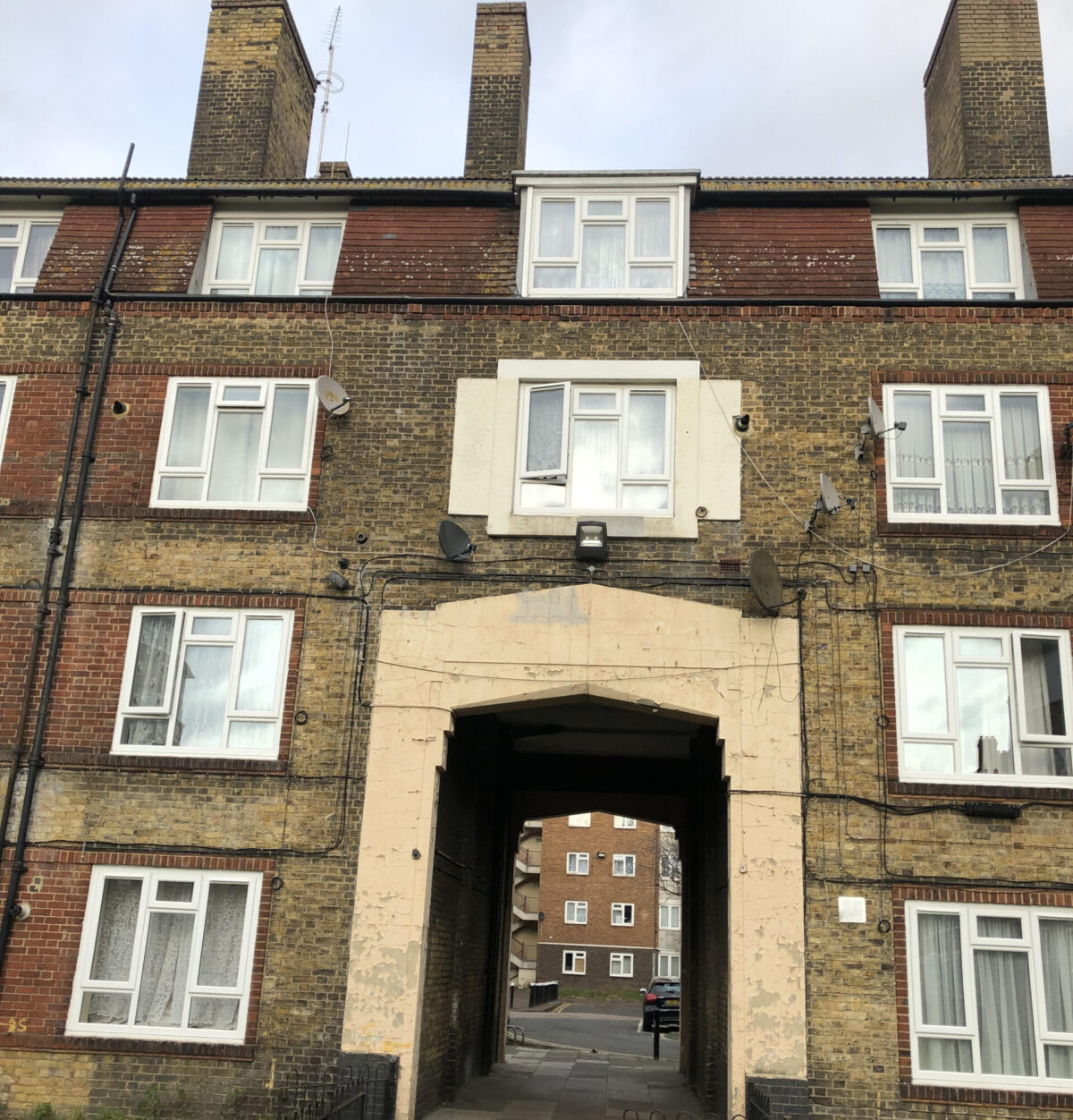On a cold January morning local councillors, tenants’ reps and Stephanie Cryan, Southwark’s lead councillor for housing, are walking around the Longfield estate in South Bermondsey. The estate was built between 1930 and 1950. Next to one of the old blocks are steps down to an air raid shelter, bricked-up when the war ended. There is a big archway built into one of the blocks for coal horses to pass through and the older blocks are only four floors high so the coal man would not have to walk up too far. The kitchens are small because middle class architects thought working class families spent too much time in the kitchen and should spend their time together in the living room.
The councillors are asking for the communal staircases to be painted. Stephanie runs through the major works needed across the borough. The cost of keeping Southwark’s communal heating systems working, plus decarbonisation is £350m. On top of this is the cost of fire safety works, keeping lifts working and buildings watertight.
Walking around the estate, it is as well-kept as it can be without major investment, with no signs of any vandalism. The active Tenants and Residents Association has successfully campaigned for an outdoor gym and children’s play facilities. It is typical of thousands of estates across the country. If we can understand why residents on the Longfield estate are having to wait for their estate to be decorated we will understand the way council housing is funded, or rather underfunded.
The trail quickly gets tricky. The estate built by the old Bermondsey Borough Council, would have been funded by a mixture of government subsidy and local authority rates (now council tax) and borrowing. Where we are on firm ground is the knowledge that if the rents paid over the years by Longfield estate tenants had been ring-fenced between when the estate was built and today, the debt would have been paid off, the management and maintenance costs covered and there would be a substantial surplus to pay for the extensive modernisation of the estate. Unfortunately for many years the money paid by Longfield estate tenants and the costs of running the estate have been swallowed up by local and national rent and cost pooling. So more investigation is needed.
There is income pooling within the council. Over the years Southwark has had, exactly what Stephanie is describing today, more problematic estates that have demanded more extensive works to keep them liveable.
However the bigger picture is more significant. Historically council tenants’ rent money has leaked away to pay for other national and local commitments, such as keeping the rates bill down. A detailed history is provided by Martin Wicks, Labour Campaign for Council Housing in his blog:
https://thelabourcampaignforcouncilhousing.files.wordpress.com/2021/02/caseforcancellingchdebt.pdf
In the 1980 Housing Act the notion of a ring-fenced Housing Revenue Account was introduced. The idea was that within each council area tenants’ rents should be spent on paying off historic debts and the management and maintenance of their housing. As Wicks demonstrates, this turned out to be a fiction, with council tenants not on housing benefit paying towards the housing benefits of council tenants who needed support. Also, the Conservative Government imposed the Right to Buy on local councils, which still represents this country’s largest privatisation with 1.8m council homes being sold with an estimated value of £6.4m.
The financing of council housing was under the control of central Government, with councils only finding out what their annual allocation would be three months before the start of the financial year. The effect was that councils who were the custodians of a housing stock with a combined value of billions could only plan a year ahead, when a long-term asset management strategy was needed.
The last Labour Housing Minister, John Healey, listened to campaigners and decided that housing should truly be self-financing, at least in future. The idea of self-financing Housing Revenue Accounts was entirely sound, even in the context of historic injustices. Councils for the first time could implement a proper asset management strategy, over 30 years. Councils had certainty over their income, rents would increase with inflation and they could predict income from leaseholders’ service charges. On the expenditure side, councils could assess their stock and have a long-term plan for major works and management.
The problem with Healey’s sound policy was that the level of debt inherited by councils was determined by the incoming Conservative Government, committed to austerity. Wicks argues that the Treasury manipulated the debt settlement and imposed a debt settlement of £26bm, far higher than the actual debt. The debt was divided, unevenly, between the 169 English councils who still owned council housing. A critical assumption was that at least central Government would let councils get on with the running of their council housing.
The concept of self-financing Housing Revenue Accounts was introduced in the 2011 Localism Act and became operational in April 2012. Since its introduction, the financial situation for council tenants has become significantly worse. There was no legal protection for local councils written into the Localism Act guaranteeing that the debt would be renegotiated or written-off if circumstances changed. However, critically, Part 7, Chapter 3, clause 169, does allow for the level of debt to be reassessed if there is a ‘change in any matter taken into account when making the original settlement’. Councils do not have a legal right to demand a reconsideration, but the door is open to make a reasoned case.
The primary assumption that underpins self-financing is that there would be certainty over income and that rents would increase at least with inflation each year. However for wider political reasons, George Osborne imposed a 1% per year rent cut for four years, wrecking newly written Housing Revenue Account business plans.
The Grenfell tragedy has raised the profile of fire and building safety, with legislation on its way requiring councils to undertake billions of pounds of work that no one envisaged when preparing their business plans. Also, not written into business plans is the steep acceleration on spending required to decarbonise council housing as a response to the climate emergency.
Councils are now committed to tackling damp and have accepted that a tenant’s lifestyle cannot be used as a reason to avoid responsibility. Damp is an issue for some tenants on the Longfield estate, as the estate is single brick, rather than the more modern cavity wall, with insulation.
Some councils experienced a significant dip in rent and leaseholder income during the pandemic, particularly as there was a moratorium on taking legal action against tenants in arrears. This problem will outlast lockdown, as the county court system has collapsed, meaning that legal action to recover outstanding debts will take years.
It was optimistically hoped that Housing Revenue Account surpluses could contribute towards the cost of building new council homes. However, building costs have spiralled. There is also an equity issue about whether council tenants, on lower than the local average income, should be paying for tackling the societal problems of climate change and homelessness. Even if the outstanding debt disappears councils will still need significant government capital funding to start to address 40 years of underfunding.
Unsurprisingly, the self-financing settlement is imploding. Wicks reports that the council housing debt bill was virtually unchanged at £25.95bn in 2019/20. One part of the explanation is that councils have to start by paying off the interest before they can start to reduce the principal. Additionally there is the irony of councils saddled with debt being forced to borrow more to meet their commitments. At least one council with a high starting debt and huge safety requirements has agreed the deferment of debt payments with the Government.
There is the possibility that the historic debt on council housing will become a version of the student loan debt, whereby the Government accepts that the debt cannot be paid back, but it stays on the balance sheet as an asset. Whilst delaying debt repayments provides short-term relief, the problem with this approach is that councils will need to hold sufficient reserves in their Housing Revenue Accounts to pay the government the back-payments if they are demanded. This means that council housing will continue to be denied the investment it needs.
What our investigation has revealed is that residents on the Longfield estate, along with most other tenants are not getting the modernization that council tenants collectively have paid for. This issue is disguised because in much of the country council rents are substantially below private rents. Council rents are sub-market, but this is because they much more closely reflect the actual cost of providing and managing housing. Market rents are high because a substantial profit is being made.
Wicks was instrumental in the drafting of the housing motion passed at the Labour Party’s 2021 conference. Attention has been focused on the commitment to build 100,000 new council houses per year. However another important clause in the motion referred to the need to maintain the council housing we already have and specifically to ‘review council housing debt to address the underfunding of the Housing Revenue Account’.
Wicks makes the case that the ‘bogus debt’ should be written off. This is not as outlandish as it may seem. To put the £26bn debt into context, housing expert, Anna Minton, writing in the Financial times on 21.1.22, estimates that the cost of quantitative easing in the 7 years after 2008 was £445bn and the cost of emergency pandemic relief was £455bn. Chancellor Rishi Sunak is estimated to have written off £4.3bn furlough and other business relief payments that were fraudulently claimed. Writing off a bogus debt of £26bn no longer seems such a big ask.
Whilst council housing financing remains so opaque and unfair, the residents of Longfield estate know that they are getting a bad deal, without knowing why.

